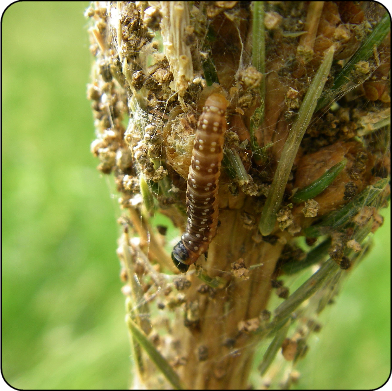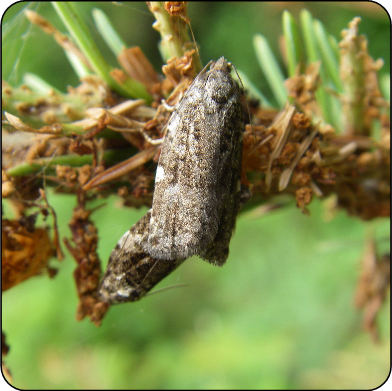Spruce budworm
Information about spruce budworm (Choristoneura fumiferana), a native forest defoliating insect found in Ontario.
Overview
- Native to North America.
- Spruce budworm is the most destructive pest of spruce and fir forests in North America.
- The larvae are wasteful feeders as they only eat partial needles and then move on to other needles.
- Spruce budworm prefers balsam fir, but the name is associated with spruce as white spruce is a more desirable species historically to the forest industry.
Host species
Spruce budworm feeds primarily on balsam fir (Abies balsamea) and white spruce (Picea glauca).
Species identification and life cycle
- Moths emerge in late June to early August.
- Adult moths have a wing span of 20 mm, forewings are dull grey with bands and spots of brown, and the hind wings are light grey.
- Adults lay egg masses (15-50 eggs) on the underside of needles in the mid-to-upper crown of host trees; eggs hatch in approximately 10 days.
- Larvae overwinter and emerge in the spring and mine previous year’s needles, unopened buds, male flowers, and then move to new shoots.
- Majority of feeding is done in mid-to-late June.
- Mature larvae are about 22 mm long, with a black head and a reddish brown body that is lighter on the sides and has two rows of whitish spots on the back.
- Pupation (when adult characteristics develop) occurs at feeding sites or on lower branches.


Symptoms and damage
- In May, small larvae hang from a thread on host species; mined old needles appear yellow with a small amount of silk at entrance holes.
- In late June and early July, host trees have a reddish appearance as partially eaten needles have dried up and are mixed in with spruce budworm frass (excrement) and held together with silk.
- 3 to 5 years of consecutive severe defoliation can result in top/whole tree mortality.
- It also feeds on black spruce (Picea mariana), eastern hemlock (Tsuga canadensis), jack pine (Pinus banksiana), eastern white pine (Pinus strobus) and larch (Larix laricinia).

Control measures
Spruce budworm can be controlled with aerial spraying of the bacterial insecticide Bacillus thuringiensis kurstaki (Btk).
Updated: May 20, 2021
Published: July 18, 2014